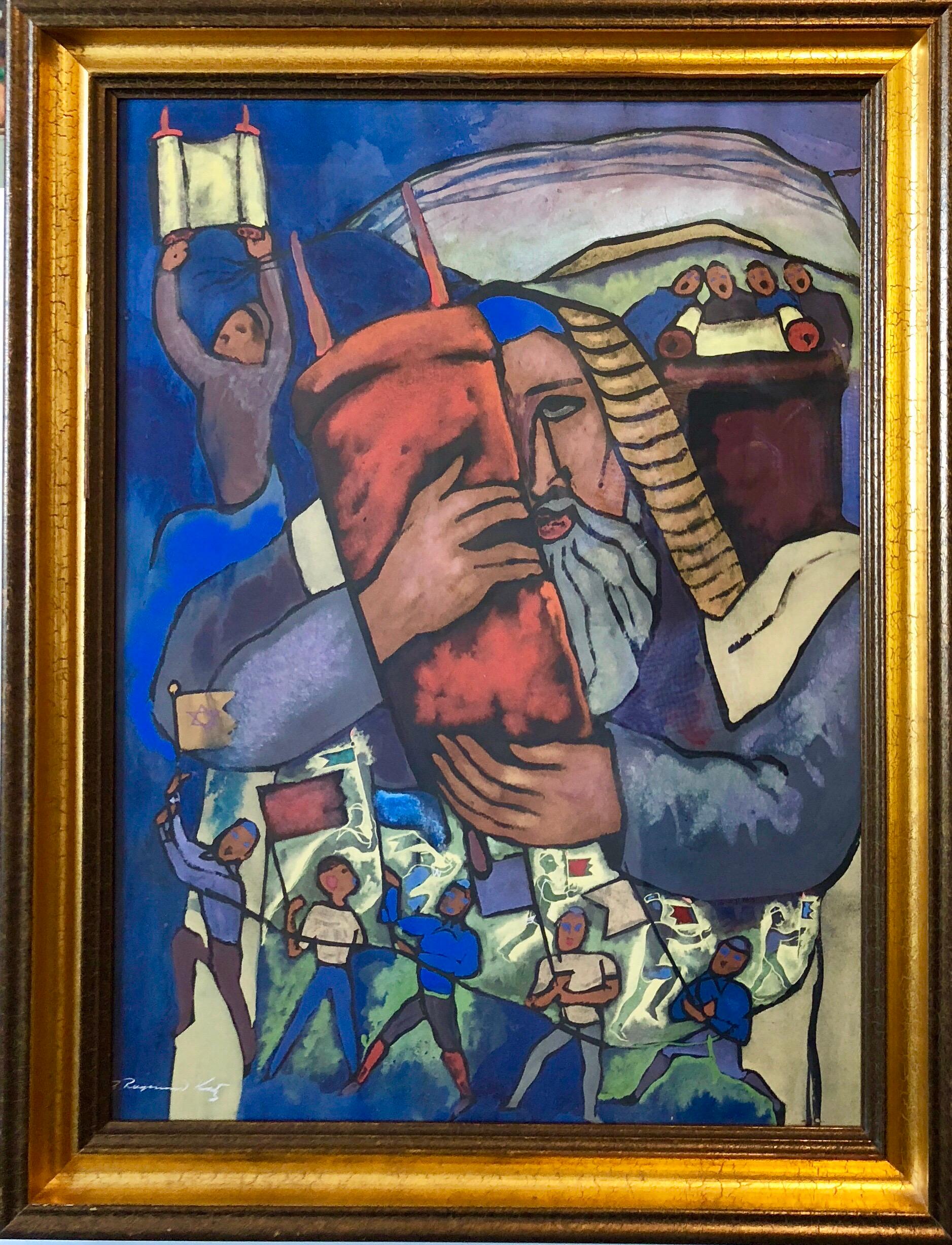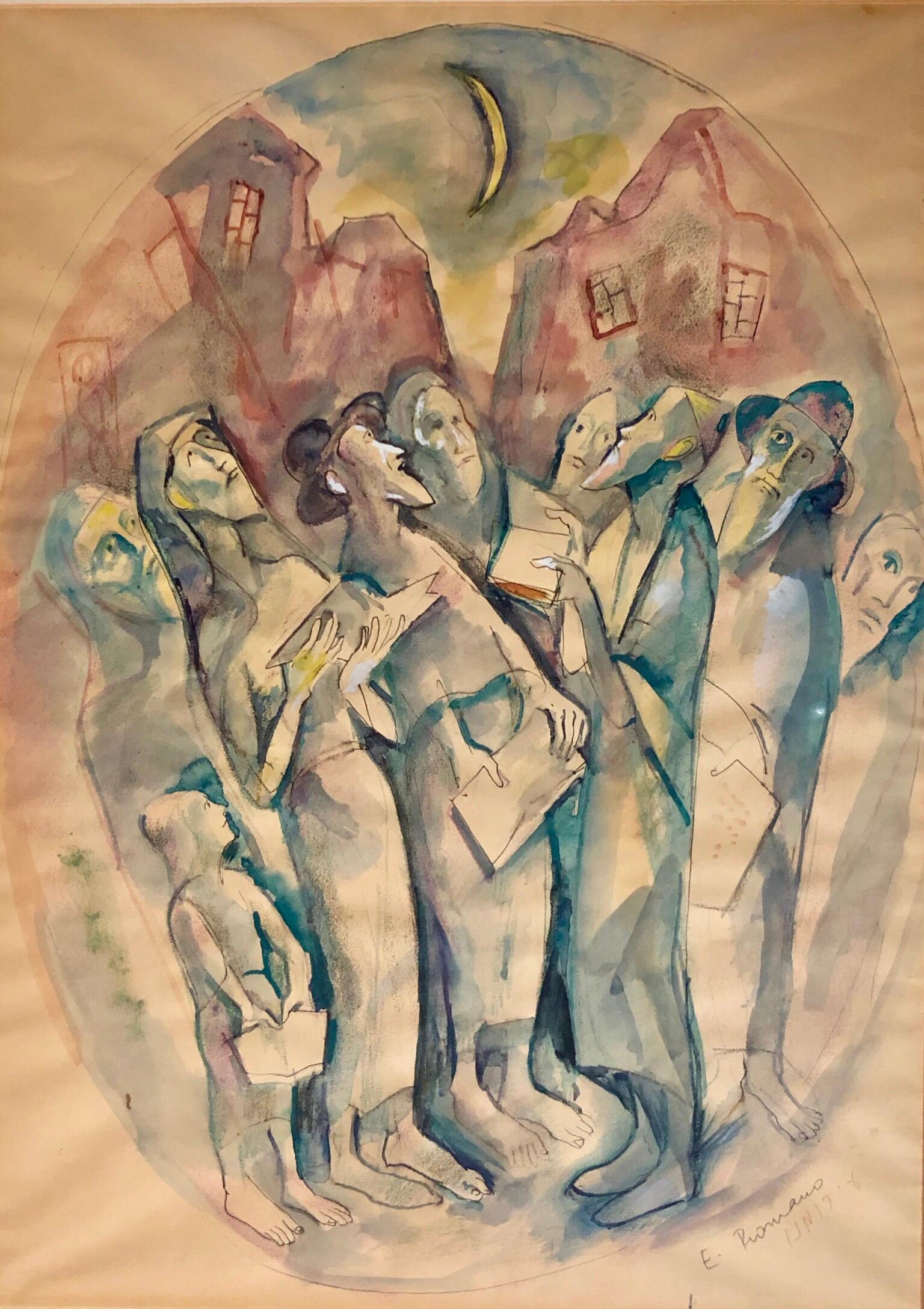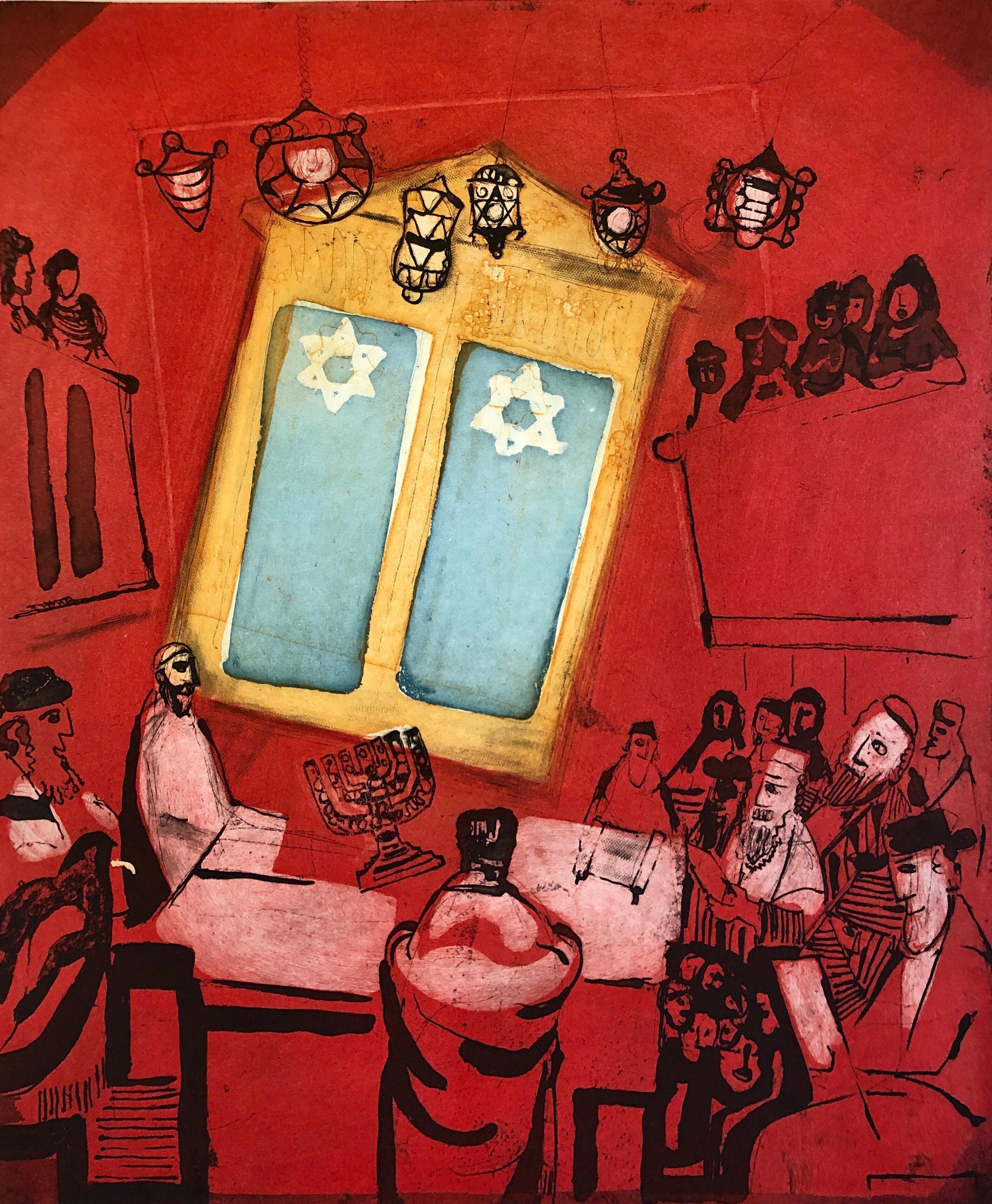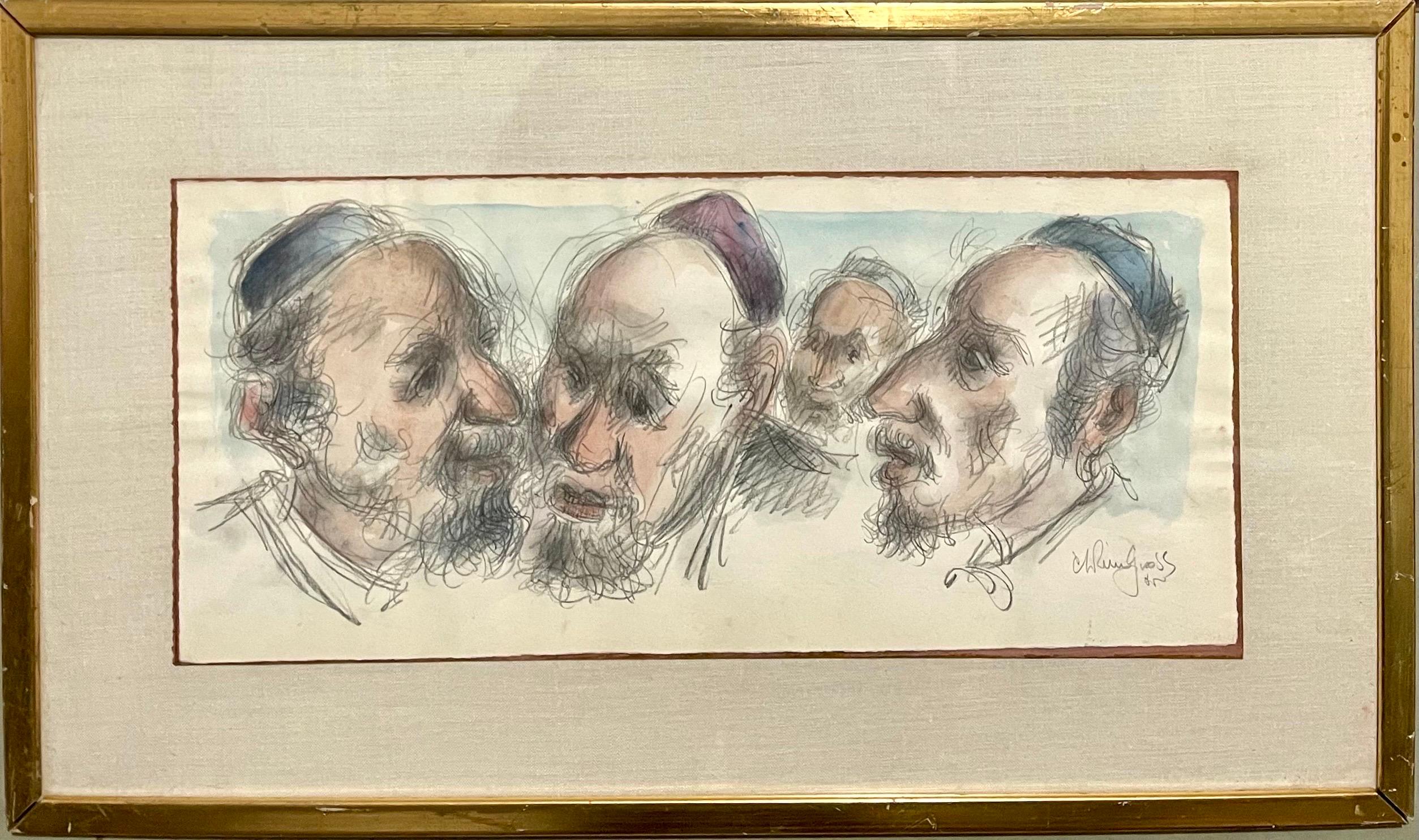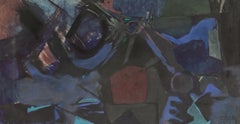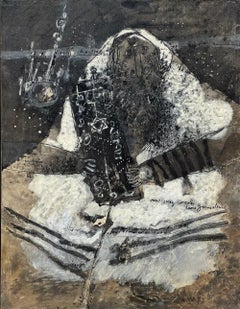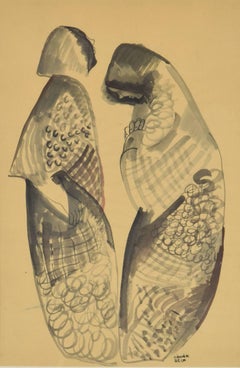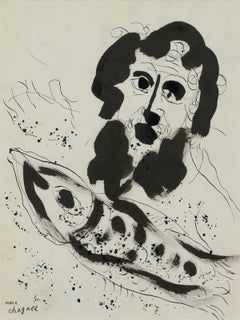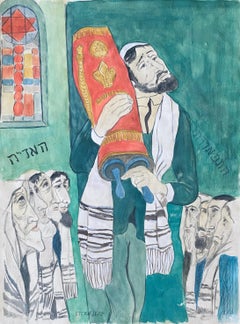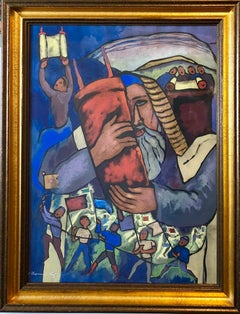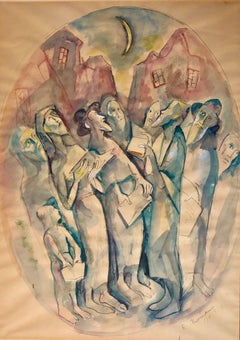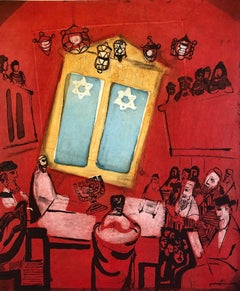Items Similar to Lifting the Torah by Ludwig Meidner - Religious scene, work on paper
Want more images or videos?
Request additional images or videos from the seller
1 of 8
Ludwig MeidnerLifting the Torah by Ludwig Meidner - Religious scene, work on paper1943
1943
$25,000
£18,989.54
€21,882.39
CA$35,206.19
A$39,031.27
CHF 20,512.46
MX$477,678.72
NOK 256,179.71
SEK 240,450.29
DKK 163,338.47
About the Item
Lifting the Torah by Ludwig Meidner (1884-1966)
Watercolour on paper
67 x 56 cm (26 ³/₈ x 22 inches)
Signed upper right, LM
Executed in 1943
- Creator:Ludwig Meidner (1884 - 1966, German)
- Creation Year:1943
- Dimensions:Height: 26.38 in (67 cm)Width: 22.05 in (56 cm)
- Medium:
- Period:
- Condition:
- Gallery Location:London, GB
- Reference Number:1stDibs: LU261211233622
About the Seller
5.0
Recognized Seller
These prestigious sellers are industry leaders and represent the highest echelon for item quality and design.
Gold Seller
Premium sellers maintaining a 4.3+ rating and 24-hour response times
Established in 1964
1stDibs seller since 2015
104 sales on 1stDibs
Typical response time: 2 hours
Associations
Society Of London Art Dealers
- ShippingRetrieving quote...Shipping from: London, United Kingdom
- Return Policy
Authenticity Guarantee
In the unlikely event there’s an issue with an item’s authenticity, contact us within 1 year for a full refund. DetailsMoney-Back Guarantee
If your item is not as described, is damaged in transit, or does not arrive, contact us within 7 days for a full refund. Details24-Hour Cancellation
You have a 24-hour grace period in which to reconsider your purchase, with no questions asked.Vetted Professional Sellers
Our world-class sellers must adhere to strict standards for service and quality, maintaining the integrity of our listings.Price-Match Guarantee
If you find that a seller listed the same item for a lower price elsewhere, we’ll match it.Trusted Global Delivery
Our best-in-class carrier network provides specialized shipping options worldwide, including custom delivery.More From This Seller
View AllComposition by Arikha Avigdor - Post-war and Contemporary gouache, c. 1955
Located in London, GB
Composition by Arikha Avigdor (1929-2010)
Gouache on paper
39 x 75 cm (15 ³/₈ x 29 ¹/₂ inches)
Signed lower right
Executed circa 1955
This work is an fine example of the Avigdor’s a...
Category
1950s Contemporary Abstract Drawings and Watercolors
Materials
Paper, Gouache
Vous serez consolés dans Jérusalem by Theo Tobiasse - Mixed media
By Théo Tobiasse
Located in London, GB
Vous serez consolés dans Jérusalem by Theo Tobiasse (1927-2012)
Mixed media on paper laid on canvas
65 x 50 cm (25 ⁵/₈ x 19 ³/₄ inches)
Signed and dated 1966
Provenance
Private coll...
Category
1960s Modern Mixed Media
Materials
Canvas, Paper, Mixed Media
Two Figures by Béla Kádár - Hungarian artist, works on paper, Hungarian folklore
By Bela Kadar
Located in London, GB
Two Figures by Béla Kádár (1877–1956)
Ink wash on paper
52 x 35 cm (20 ½ x 13 ¾ inches)
Signed lower right, KÁDÁR BÉLA
Provenance: Susie Kádár, daughter of the artist
Artist biogra...
Category
20th Century Post-Impressionist Figurative Drawings and Watercolors
Materials
Ink, Paper
Jonas by Marc Chagall - School of Paris, Russian Artist
By Marc Chagall
Located in London, GB
*PLEASE NOTE UK BUYERS WILL ONLY PAY 5% VAT ON THIS PURCHASE.
Jonas by Marc Chagall (1887-1985)
Indian ink on paper
35.6 x 26.9 cm (14 x 10 ⅝ inches)
Signed with Estate stamp lower ...
Category
1950s Modern Figurative Drawings and Watercolors
Materials
Paper, India Ink
A pair of Portraits of a Rabbi by José Schneider
Located in London, GB
A pair of Portraits of a Rabbi by José Schneider (1848-1893)
Oil on canvas
2 parts, 21.2 x 18.4 cm (8 ³/₈ x 7 ¹/₄ inches) each
Signed lower left on second panel, José Schneider
Category
19th Century Figurative Paintings
Materials
Canvas, Oil
$1,424 Sale Price
20% Off
Les Voiles by Léopold Survage - Abstract watercolour, Landscape, Modern
By Léopold Survage
Located in London, GB
Les Voiles by Léopold Survage (1987-1968)
Watercolour on paper
23 x 38 cm (9 x 15 inches)
Monogrammed, stamped and dated lower right
Executed in 1945
Provenance
Private collection, ...
Category
1940s Surrealist Abstract Drawings and Watercolors
Materials
Paper, Watercolor
You May Also Like
Modernist Rabbi In Synagogue Judaica Watercolor Harry Sternberg
By Harry Sternberg
Located in Surfside, FL
Harry Sternberg, artist, teacher, and political activist was born in New York City's lower east side in 1904. He was the youngest of eight children born to his mother, a hungarian im...
Category
20th Century Modern Figurative Paintings
Materials
Ink, Watercolor
Chicago Jewish Modernist Judaica Painting Simchat Torah WPA Artist Israeli Flags
By Alexander Raymond Katz
Located in Surfside, FL
This has young ISraeli pioneers dancing with the flag as typical of works of the late British mandate Palestine era early state of Israel.
Genre: Modern
Subject: Figurative (stained glass style)
Medium: Mixed media gouache on paper
Hand signed lower left
Alexander Raymond Katz, Hungarian / American (1895 – 1974)
Alexander Raymond Katz was born in Kassa, Hungary, and came to the United States in 1909. He studied at the Art Institute of Chicago and the Chicago Academy of Fine Arts. In the late 1920s, he worked as a director of the Poster Department at Paramount Studios. He was appointed the Director of Posters for the Chicago Civic Opera in 1930.
During the Great Depression, notable architect Frank Lloyd Wright urged Katz to become a muralist. In 1933, he was commissioned to paint a mural for the Century of Progress exposition in Chicago. In 1936, he painted the mural History of the Immigrant for the Madison, Ill., post office. Katz’s works were included in various exhibitions and now are part of several museum collections, including those of the Art Institute of Chicago; Corcoran Gallery of Art, Washington, D.C.; and the Jewish Museum, New York. His murals, bas-reliefs and stained glass designs adorn more than 200 Jewish synagogues in the United States.
Katz and other Jewish artists in Chicago who expressed Jewish and Biblical themes were inspired by the artist Abel Pann (1883-1963). Pann, who is regarded as the leading painter of the Land of Israel, exhibited in the Art Institute of Chicago in 1920.
Early in his career, Katz began to explore the artistic possibilities inherent in the characters of the Hebrew alphabet. He developed aesthetic and philosophical interpretations of each letter and became the leading innovator and pioneer in the field of Hebraic art.
Katz applies this concept in the woodcut Moses and the Burning Bush. Hebrew letters appears in Moses’ head, his cane and inside the flame. The initial of Moses’ name crowns his head. The letter in the flame is the first letter of the name of God. A combination of images and Hebrew letters appeared commonly in illustrations of the scene Moses and the Burning Bush in the Haggadah, the book of Passover.
The symbolism of the burning bush corresponds to the motifs of A Gift to Biro-Bidjan. Among the fourteen participating artists were notable Chicago modernists Todros Geller, Mitchell Siporin...
Category
Mid-20th Century Modern Figurative Paintings
Materials
Paper, Gouache
Modernist Watercolor Painting Judaica Kiddush Levana Blessing New Moon
By Emanuel Glicenstein Romano
Located in Surfside, FL
Genre: Judaic prayer scene
Subject: Landscape
Medium: watercolor
Surface: Paper
Country: United States
EMANUEL ROMANO
Rome, Italy, b. 1897, d. 1984
Emanuel Glicenstein Romano was born in Rome, September 23, 1897.
His father Henryk Glicenstein was a sculptor and was living in Rome with his wife Helena (born Hirszenberg) when Emanuel was born his father obtained Italian citizenship and adopted the name Enrico. Emanuel was brought up in Italy, Switzerland, Germany, England and Poland.
In 1926 Emanuel and his father sailed for New York. They briefly visited Chicago. Romano's sister, Beatrice, and mother only joined them in New York years later.
Romano changed his name on his arrival to America and some have erroneously speculated that this was to avoid antisemitic anti Jewish discrimination. In truth, as the son of a highly-regarded artist, Romano changed his name to ensure that any success or recognition he would later attain, would be the result of nothing other than his own merit as an artist, and not on account of his father's fame.
In 1936 Romano was worked for the Federal Art Project creating murals. During and immediately after World War II, Romano created a series of allegorical works depicting graphic holocaust images that were held closely by the family until after his passing. One of these works is now on permanent display in the Florida Holocaust Museum in St. Petersburg Florida.
Emanuel's father died in 1942 in a car accident before they could realize their shared dream of visiting Israel.
In 1944 Romano, having completed his degree at the Pennsylvania Academy of Fine Arts and the Art Institute of Chicago, began teaching at the City College of New York.
Romano moved to Safed, Israel in 1953 and established an art museum in his father's memory, the Glicentein Museum.
COLLECTIONS
Indianapolis Museum of Art
Metropolitan Museum of Art
Boston Fine Arts Museum
Fogg Museum
Musée Nacional de France
Recently his work has been added to the Florida Holocaust Museum collection. His notable works include his holocaust themed allegorical paintings as well as portraits of Marianne Moore, his father and William Carlos Williams...
Category
20th Century American Modern Figurative Paintings
Materials
Paper, Watercolor
Modernist Judaica Art Aquatint Etching Jewish Rabbi at Prayer Jerusalem Memories
By Lennart Rosensohn
Located in Surfside, FL
Swedish Jewish modern art. On Hahnemuhle paper, hand signed and numbered. poster is not included.
These depict synagogue interiors, Rabbis at prayer ...
Category
20th Century Modern Figurative Prints
Materials
Etching, Aquatint
Parading the Torah, Impressionist Oil Painting on Canvas by Adolf Adler
By Adolf Adler
Located in Long Island City, NY
Artist: Adolf Adler, Romanian (1917 - 1996)
Title: Parading the Torah
Year: circa 1965
Medium: Oil on Canvas, signed l.r.
Size: 19.5 x 27.5 in. (49.53 x 69.85 cm)
Frame Size: 21 x 29...
Category
1960s Impressionist Figurative Paintings
Materials
Oil, Canvas
$3,600 Sale Price
20% Off
Chaim Gross Mid Century Mod Judaica Jewish Watercolor Painting Rabbis WPA Artist
By Chaim Gross
Located in Surfside, FL
Chaim Gross (American, 1904-1991)
Watercolor painting
Rabbinical Talmudic Discussion
Hand signed
17 x 29 framed, paper 10 x 22
Chaim Gross (March 17, 1904 – May 5, 1991) was an ...
Category
Mid-20th Century American Modern Figurative Drawings and Watercolors
Materials
Paper, Watercolor
More Ways To Browse
Torah Art
Torah Paintings
18th Century Dutch Watercolors
Charles Moulin
Vintage Fashion Sketches
Erotic Watercolors 1940s
Mermaid Drawing
Stanley Feldman
Arpege Lanvin
Jean Francois Millet Drawing
John Carlisle
Cyclops Painting
Arpege Lanvin Vintage
Joan Carl Sculpture
Windsor Castle Watercolor
Alice Adams
Avery Chair
Joan Jonas

